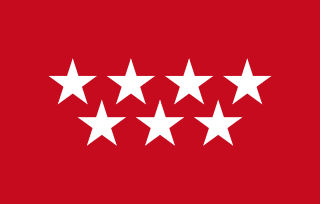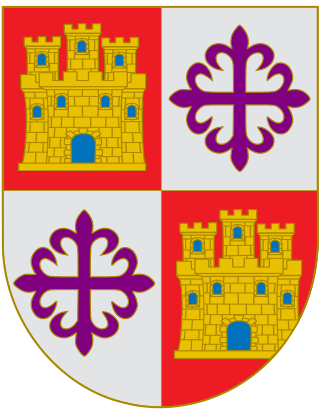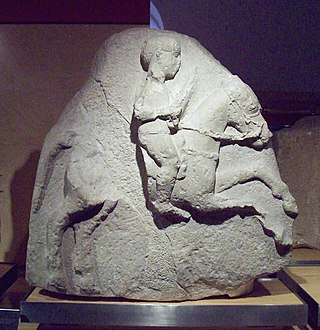
Andalusia is the southernmost autonomous community in Peninsular Spain. It is the most populous and the second-largest autonomous community in the country. It is officially recognised as a historical nationality and a national reality. The territory is divided into eight provinces: Almería, Cádiz, Córdoba, Granada, Huelva, Jaén, Málaga, and Seville. Its capital city is Seville. The seat of the High Court of Justice of Andalusia is located in the city of Granada.
Castile or Castille is a territory of imprecise limits located in Spain. The invention of the concept of Castile relies on the assimilation of a 19th-century determinist geographical notion, that of Castile as Spain's centro mesetario with a long-gone historical entity of diachronically variable territorial extension.

In Spain, an autonomous community is the first sub-national level of political and administrative division, created in accordance with the Spanish Constitution of 1978, with the aim of guaranteeing limited autonomy of the nationalities and regions that make up Spain.
Adelantado was a title held by some Spanish nobles in service of their respective kings during the Middle Ages. It was later used as a military title held by some Spanish conquistadores of the 15th, 16th and 17th centuries.

The Castilian Left is a leftist nationalist political movement active in the Spanish autonomous communities of Castile-La Mancha, Castile and Leon and Community of Madrid. It strives to advocate for the national recognition of Castile, and in some cases, its independence. Other current political parties include Tierra Comunera, Castilian Party, and Ahora Castilla.

Andalusian nationalism is the nationalism that asserts that Andalusians are a nation and promotes the cultural unity of Andalusians. In the past it was considered to be represented primarily by the Andalusian Party. However, the party disbanded in 2015; there are also lesser political organisations that identify with Andalusian nationalism. Some political forces without parliamentary presence like Nación Andaluza and Asamblea Nacional de Andalucía may be found advocating independence. There is also a movement defending the idea that Andalusian is not a dialect of Spanish, but a language of its own.

Both the perceived nationhood of Spain, and the perceived distinctions between different parts of its territory derive from historical, geographical, linguistic, economic, political, ethnic and social factors.

The Andalusia national football team is the national football team of Andalusia. They are not affiliated with FIFA or UEFA, because Andalusia is represented internationally by the Spain national football team. It mostly plays only friendly matches.

The Platform for Eastern Andalusia is a Spanish organization with regionalist character, set up juridically as an association, created from a civic initiative in the provinces of Jaén, Granada and Almería, with the objective of forming an autonomous community including these three provinces as Eastern Andalusia.
After the 1494 territorial division of South America between Spain and Portugal in the Treaty of Tordesillas, the colonial administration of the continent was divided into Governorates.

United Left is a federative political movement in Spain that was first organized as a coalition in 1986, bringing together several left-wing political organizations, most notably the Communist Party of Spain.

The Royal Madrid Football Federation is the governing body of the sport of football in the Community of Madrid, Spain. Its headquarters are in the city of Madrid.

The Governorate of New Andalusia was a Spanish colonial entity in what today constitutes the Caribbean coastal territories from Central America, Colombia and Venezuela, and the islands of what today are Jamaica, Cuba, Haiti, Dominican Republic and Puerto Rico. The Government of Nueva Andalucia was set in Venezuela from 1501 to 1513.

The Madrid autonomous football team is the regional football team for the Community of Madrid, Spain. They are not affiliated with FIFA or UEFA, because the Community of Madrid is represented internationally by the Spain national football team. The team plays only friendly matches.

Enrique Enríquez the Younger was a nobleman of Castile, son of Enrique Enríquez the Elder. He was lord of Villalba de los Barros, Nogales, Almendral, La Parra, Begíjar and other towns. He was Adelantado Mayor of the border of Andalusia, chief justice of the King's House, Chief of the forces of the bishopric and Kingdom of Jaén, Mayor of Seville and Knight of the Band.

Democratic People's Federation was a Christian Democratic political organization created in 1975 by José María Gil-Robles, heir of the Christian Social Democracy of José María Gil-Robles y Quiñones.

This is the results breakdown of the European Parliament election held in Spain on 13 June 1999. The following tables show detailed results in each of the country's 17 autonomous communities and in the autonomous cities of Ceuta and Melilla.
The Office of the Public Prosecutor was created in the Autonomous communities of Spain by Royal Decree 1754/2007 of December 28.

Federalism in Spain began in the 1830s, although it has its roots in the 1790s. The first and only attempt to establish a federal state in Spain occurred during the First Spanish Republic (1873-1874). After this failure, federalism was a minority political current. In the Second Spanish Republic and in the Transition, an intermediate model was chosen between federalism and centralism — the integral state, in the first case; and the regional state in the second.

The geostrategic position of Andalusia at the southernmost tip of Europe, between Europe and Africa, between the Atlantic Ocean and the Mediterranean Sea, as well as its mineral and agricultural riches and its large surface area of 87 268 km², formed a combination of factors that made Andalusia a focus of attraction for other civilizations since the beginning of the Metal Age.















